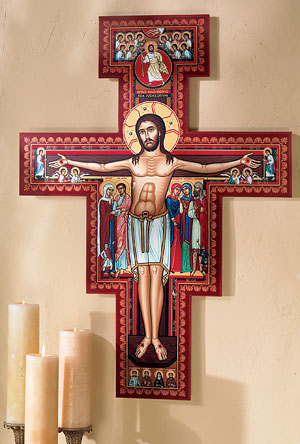
“The same things that the Book of the Gospels explains by means of words, the painter shows by means of his works.” –St. Basil the Great
An Eastern Orthodox bishop once described iconography as “theology in line and color.” The San Damiano Crucifix created for Monastery Icons demonstrates this well.
The History of the San Damiano Crucifix
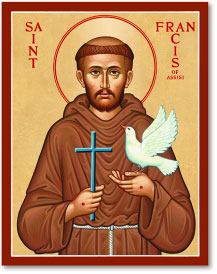 “Go repair my Church, which as you see is falling completely in ruin” – when the image of Christ in the crucifix at San Damiano miraculously spoke these words to St. Francis, he was awakened to new zeal. He first concentrated on repairing the church buildings of San Damiano and nearby churches. But his great “repair” to the Church was the founding of the Franciscan Order, which began with the followers that Christ began to send to him shortly after the vision.
“Go repair my Church, which as you see is falling completely in ruin” – when the image of Christ in the crucifix at San Damiano miraculously spoke these words to St. Francis, he was awakened to new zeal. He first concentrated on repairing the church buildings of San Damiano and nearby churches. But his great “repair” to the Church was the founding of the Franciscan Order, which began with the followers that Christ began to send to him shortly after the vision.
An unknown Umbrian artist painted the original crucifix in the twelfth century. As we can see, it is strikingly iconographic in character; because of this, many identify the artist as a Syrian monk, since there were known to have been Syrian monks in the area at that time. In 1257 the Poor Clares left San Damiano for San Gorgio, taking the crucifix with them. It was placed on public view for the first time in modern times in Holy Week of 1957, over the new altar in San Giorgio’s Chapel in the Basilica of St. Clare of Assisi.
The Symbolism in the Icon
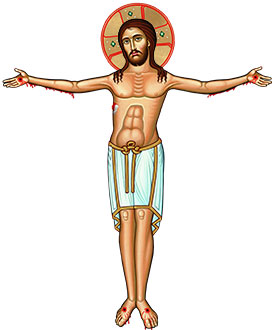 The most striking element of the San Damiano Crucifix is the figure of Christ. It is not the body of a corpse, but of God Himself, incorruptible unto eternity and the source of life, radiating the hope of the Resurrection. The Savior looks directly at us with a compassionate gaze, regal, triumphant, and strong. He does not hang on the Cross, but rather seems to be supporting it, standing in His full stature. His hands are not cramped from being nailed to the wood, but rather spread out serenely in an attitude of both supplication and blessing, which our iconographer has further emphasized by Jesus’ tranquil and gentle expression. This iconographic Crucifix does not express the brute horror of death by crucifixion, but rather the nobility and gentleness of eternal life.
The most striking element of the San Damiano Crucifix is the figure of Christ. It is not the body of a corpse, but of God Himself, incorruptible unto eternity and the source of life, radiating the hope of the Resurrection. The Savior looks directly at us with a compassionate gaze, regal, triumphant, and strong. He does not hang on the Cross, but rather seems to be supporting it, standing in His full stature. His hands are not cramped from being nailed to the wood, but rather spread out serenely in an attitude of both supplication and blessing, which our iconographer has further emphasized by Jesus’ tranquil and gentle expression. This iconographic Crucifix does not express the brute horror of death by crucifixion, but rather the nobility and gentleness of eternal life.
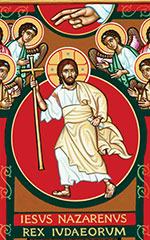 Above His head is a portrayal of the Ascension: Christ emerging from a red circle, holding a golden cross which is now His sceptre. A host of angels welcome him into heaven, while at the very top of this scene the right hand of God the Father is extended in benediction.
Above His head is a portrayal of the Ascension: Christ emerging from a red circle, holding a golden cross which is now His sceptre. A host of angels welcome him into heaven, while at the very top of this scene the right hand of God the Father is extended in benediction.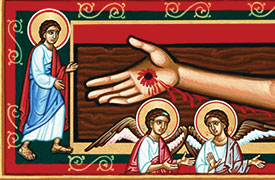 Beneath this scene is the Latin inscription described in the Gospels: “Jesus of Nazareth, King of the Jews.”
Beneath this scene is the Latin inscription described in the Gospels: “Jesus of Nazareth, King of the Jews.”
Around the crossbar of the cross we see a company of holy angels, looking in awe upon the Divine Sacrifice. Their hand gestures indicate their animated discussion of this wondrous event.
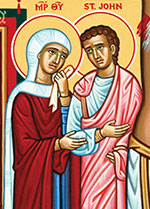
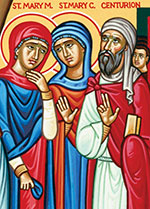 To the left of the central figure of Christ at the foot of the cross stand the Holy Virgin and Saint John the Evangelist stand at the foot of the cross – “His Mother and the disciple whom He loved.” To the right stand Saint Mary Magdalene, Saint Mary Cleophas, and the Centurion. The Centurion holds a piece of wood, indicating his building of the synagogue (Luke 7:1-10); the little boy behind him is his son, healed by Jesus. In the lower right- and lefthand corners of this seen are small figures of the Roman soldier Longinus and and the Jewish temple guard Stephaton – one holding the lance that pierced the Savior’s side, and the other holding a stick with a vinegar-soaked sponge.
To the left of the central figure of Christ at the foot of the cross stand the Holy Virgin and Saint John the Evangelist stand at the foot of the cross – “His Mother and the disciple whom He loved.” To the right stand Saint Mary Magdalene, Saint Mary Cleophas, and the Centurion. The Centurion holds a piece of wood, indicating his building of the synagogue (Luke 7:1-10); the little boy behind him is his son, healed by Jesus. In the lower right- and lefthand corners of this seen are small figures of the Roman soldier Longinus and and the Jewish temple guard Stephaton – one holding the lance that pierced the Savior’s side, and the other holding a stick with a vinegar-soaked sponge.
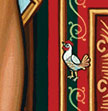 Near the border of the Cross on the right, just below the level of Christ’s knees, you will find a small rooster. This recalls the denial of Peter, who wept bitterly, and reminds us that we should not be presumptuous of the strength of our faith.
Near the border of the Cross on the right, just below the level of Christ’s knees, you will find a small rooster. This recalls the denial of Peter, who wept bitterly, and reminds us that we should not be presumptuous of the strength of our faith.
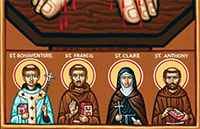 At the very bottom of the Cross the original artist depicted several saints. Their visages in the original cross were damaged over the centuries and are now unrecognizable. In this recreation of the icon, the iconographer has chosen to identify and depict these saints as the four most beloved saints of the Franciscan Order: Saint Francis, Saint Clare, Saint Anthony of Padua, and Saint Bonaventure.
At the very bottom of the Cross the original artist depicted several saints. Their visages in the original cross were damaged over the centuries and are now unrecognizable. In this recreation of the icon, the iconographer has chosen to identify and depict these saints as the four most beloved saints of the Franciscan Order: Saint Francis, Saint Clare, Saint Anthony of Padua, and Saint Bonaventure.
Truly, as Saint Basil the Great wrote, “With a soundless voice the icons teach those who behold them.”
The Prayer of Saint Francis before the Cross at San Damiano
“Most High glorious God, bring light to the darkness of my heart. Give me right faith, certain hope, and perfect charity, insight and wisdom, so I can always observe Thy holy and true command. Amen.”